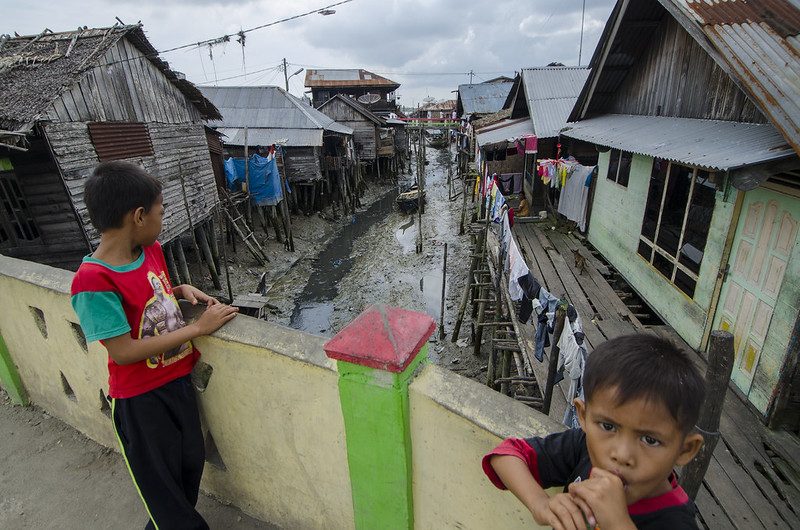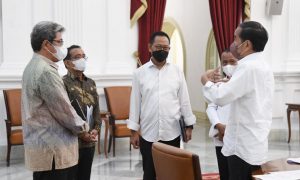The North Sumatran government’s poor performance in implementing the UN SDGs, particularly on climate action (goal 13) and peace, justice, and strong institutions (goal 16), has confused the direction of the 2030 SDGs, which, according to Indonesia’s national implementation road map, should be driven by local governments. An absence of participatory processes and transparency in the local government’s planning, implementation, and evaluation of the SDGs exemplifies this issue; moreover, they make limited contributions to mainstreaming discourse on these goals.
This picture emerges from the data gathered through in-depth interviews, in June 2021, with informants who are actively involved in churches and church-affiliated institutions in North Sumatra. This provided a different picture than the Indonesian government’s Voluntary National Review (VNR). Our data collection on goal 13 focused on climate action, natural disasters, and developing an environment-friendly economy. For goal 16, we focused on violence, religious freedom, basic rights for women, children, and religious minorities, transparency in local governance, inclusive and participatory decision-making.
Based on churches’ experiences, the local government appears to be taking no clear steps toward mitigating natural disasters and climate change, nor in developing a civil society network for mitigation. Simultaneously, the North Sumatra region has experienced floods and landslides as a result of deforestation and extreme weather.
The local government’s performance appears to involve ad hoc participation in public seminars on disaster management or by providing plant seeds to churches and affiliates. There has been no strategic collaboration with churches toward disaster risk reduction. In Simalungun Regency, the church’s diaconia department received no response from the local government to requests for disaster response and infrastructure repair. The local government limited its role to ad hoc events such as the distribution of basic food aid during the COVID-19 pandemic, the provision of agricultural equipment, and collaboration on religious celebrations such as Christmas and Easter.
A slightly different picture is found in a Christian-based university located at Simalungun Regency, where collaboration with local government takes the form of tree planting activities in several locations, improving climate change-related knowledge among university students, and starting organic fertilizer developments on the campus area.
Goal 16 intersects with churches’ annual work plans, particularly concerning an increase in violence against vulnerable people, particularly women and children as a result of the COVID-19 pandemic’s social and economic impact. The situation is complicated further by a strongly patriarchal culture in a society where violence against women is usually resolved through family mechanisms or internal institutional policies (such as in schools and religion-related institutions) so that it does not become a public issue which complicates matters even further, and finally, the victim does not have access to justice. Other issues are also on the rise, such as the use of dangerous drugs, and violence against children in shelters or in the informal sector in which they are employed.
In terms of violence, the local government has been seen by some activists of the church-related institutions as failing to take proactive steps to investigate and assist victims, especially women and children, in obtaining justice. This stems from a lack of gender awareness among the government and law enforcement officers. As a result, legal assistance for victims is frequently carried out by non-governmental institutions, even though they have limited resources.
Furthermore, some of the church institution-based activists I spoke to believe the local government has failed to take proactive steps the local government performs poorly in combating youth’s illegal use of dangerous drugs (such as morphine, heroin, and other comparable drugs). As a result, based on the observation of some church-related institution activists, the use of these types of drugs continues to spread among young people. Non-governmental institutions, particularly churches and their affiliated institutions, actually play the role to respond to this challenge through their annual interfaith and educational activities.
According to the monitoring report of the 2020 Corruption Case Enforcement Performance by Indonesia Corruption Watch (ICW), there is a downward trend in combating corruption from 2015 to 2020. This downward trend is consistent with the data gathered in North Sumatra that reveals poor local government’s role in engaging civil society in monitoring government budget management and poor performance in mainstreaming anti-corruption issues.
Furthermore, weak civil society participation has led to poor implementation of a bottom-up approach to annual deliberation forums designed to accommodate local aspirations in the annual development plan. These forums are seen solely as a means for local government to gain legitimacy, rather than inclusive decision-making.
The role of the local government is more positive in the area of health and education services, but some challenges must be addressed, such as health and education access for the poor, children with disabilities, and those living with HIV/AIDS. There is an absence of strategic effort in this regard. The distribution of basic aid for people in need was not well managed during the COVID-19 pandemic, with more aid reaching those who have connections with government officials.
On the other side, the data reveals the role of churches and related institutions in initiating responses that fill the gaps left by the lack of strategic local government initiatives. Churches and their affiliated institutions have been active in developing an environment-friendly economy, and developing disaster response units or programs at the church’s department and congregational levels. However, some obstacles have hindered these efforts, such as a mindset that still views natural disasters as merely natural occurrences which complicate the formation of disaster response units, as well as the ecumenical network’s poor performance in facilitating disaster response units and SDG-related programs at the local level. [related_article]
Successful actions by churches have included tree planting and distribution through ecclesiastical events such as weddings, baptisms, and catechisms, which also contribute to raising awareness of environmental conservation.
Several churches in North Sumatra have gone even further, recycling waste and combining climate mitigation with economic development by developing organic fertilizers and pesticides to support organic agriculture, making natural clothing dyes, strengthening farmers to develop food security during the pandemic, and utilizing used materials to make cloth products that are supported by the product marketing system.
Moreover, churches use education to raise awareness among members of the congregations and institutions about natural disaster mitigation, adaptation, and climate change. This effort is taken by some churches through a process of education in Sunday schools, catechisms, and sermons. Some churches facilitate campaigns and seminars on environmental issues, as well as campaigning against the use of pesticides in agriculture.
On peace, justice, and strong institutions, churches and their affiliated institutions have been involved in providing counseling and legal aid to victims of violence. Some churches combine this assistance with economic empowerment for women, by providing training programs to develop skills in textile production, such as the production of natural clothing dyes.
Activities have also been carried out to build awareness about the protection of women and children, such as seminars and the publication and distribution of materials such as the Code of Conduct on Anti-violence Against Women and Children, the Gender Justice Policy, and the Convention on the Elimination of All Forms of Discrimination against Women (CEDAW), as well as Paralegal training. However, issues with financial support, weak ecumenical network support at the local level, and socio-cultural barriers make it difficult to give effective counseling and legal assistance. Furthermore, cultural barriers frequently obstruct victim assistance, resulting in the victim‘s inability to receive justice.
Some recommendations should be considered at this point, firstly, the need for proactive steps taken by the government, at the national level and local levels, to build strategic partnerships with FBOs, such as churches and various church-related institutions, to support the acceleration of the 2030 SDGs implementation, as well as increasing gender awareness among government officials and religious institutions. This effort will strengthen the inclusive and participatory nature of the 2030 SDGs, and keep the spirit of “no one left behind” alive. Secondly, The government also has to take a proactive role in implementing farming technology that could provide food for many people by using more efficient land dan reducing land exploitation. Thirdly, the poor ecumenical structure at the local level must be addressed to support SDG-related initiatives at the local level. According to the data, many SDG-related local initiatives are carried out by churches and their related institutions without connection and assistance from the ecumenical structure at the local level.
 Facebook
Facebook  Twitter
Twitter  Soundcloud
Soundcloud  Youtube
Youtube  Rss
Rss 


